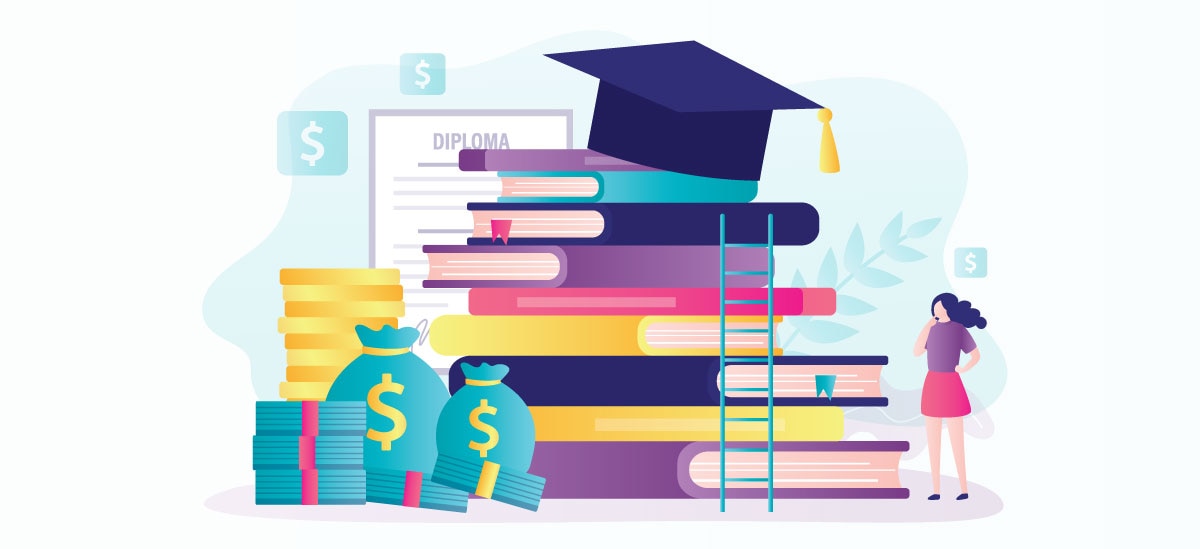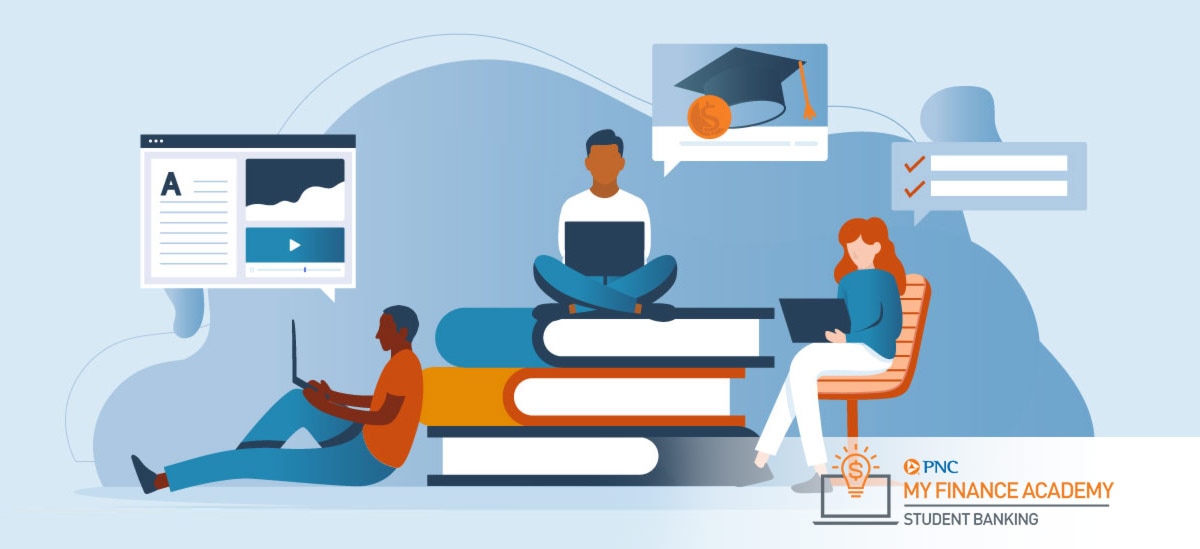
- Though higher education is costly, there are several options that may be available to you to pay for college.
- The first step in paying for college is to fill out the Free Application for Federal Student Aid (FAFSA®). This opens doors to student loans, scholarships, grants, and work-study options.
- Scholarships and grants offer “free money” to fund college educations.
- Federal and private loans can assist in paying for college.
- When thinking about how to pay for college, consider cost-cutting methods like dual-credit and AP courses, community college, and employment tuition.
- The average annual cost of attendance at a public four-year, in-state institution is $26,027 ($104,108 over four years).
- The average annual cost of attendance at a private, four-year institution is $55,840 ($223,360 over four years).
- Narrow your focus. With the multitudes of available scholarships, you might be tempted to apply to every single one. The last thing you want is to make a career out of filling out and sending in scholarship applications. Instead, restrict the search to your interests, background, and grades.
- Consider smaller scholarships. Every student dreams about a huge scholarship that will fund their college journey. In reality, many scholarships might be small. Don’t ignore the $500 or $1,000 offerings — every little bit helps pay for college.
- Work smarter, not harder. Keep an eye out for opportunities requiring minimal effort and time connected with applications and paperwork. For example, the $10,000 PNC Student Solution Scholarship offers an easy registration process. You also don't have to submit an essay or have a minimum GPA to apply.
- Subsidized loans (based on financial need), which don't accumulate interest until you leave school.
- Unsubsidized loans, where interest begins accumulating from the date you receive the funds.
- Fixed interest rates and various repayment options, including income-based plans.
- No required credit check.
- Forbearance (a pause on loan payments) in the event of financial difficulties.
- Higher borrowing limits than federally-funded student loans.
- Possible interest rate deductions on tax returns (be sure to consult with a tax advisor).
- AP courses consist of college-level work and a year-end test. Scoring well on the test means you could earn college credit for various subjects, including math, science, English, history, language, or art.
- Dual-credit courses involve a high school’s partnership with a nearby university. In this scenario, a professor teaches the class, which satisfies the requirements for high school graduation while providing college credit.
Many compelling reasons to attend college typically include higher salaries, better job security, and improved lifestyle and health.[1]
But it’s no secret that paying for that higher education opportunity is expensive. Here are some numbers to ponder:[2]
However, you don't have to completely pay for college out of pocket. While searching for the best college for your next educational path, take the time to follow these six steps, which offer helpful ways to pay for college.
1. Complete the Free Application for Federal Student Aid
Before doing anything else, take the time to fill out and submit the Free Application for Federal Student Aid (FAFSA). A successfully completed FAFSA opens the door to a host of financial assistance from federal, state, and local governments, including student loans, grants, scholarships, and work-study programs.
Despite this vital source of college aid, persistent myths abound.[3] You might think your family income is too high to qualify for financial assistance or that filling out the form is too difficult. Neither of these are true. There are many options available for every student who fills out the FAFSA.
2. Study Scholarship Sources
Scholarships provide free money to help pay higher education expenses. Unlike loans, you don’t have to pay back scholarships. FAFSA is one way to connect with scholarship money set aside by governments and schools. Another way is to locate privately funded scholarships.
A great place to begin your research is with your high school guidance counselor and targeted colleges. Then, take the search online — websites like Scholly,[4] Mos,[5] and Going Merry[6] can offer interesting scholarship options. Pay attention to potential scholarships focusing on religion, ethnicity, gender, anticipated field of study, and previous accomplishments.
Here are a few things to think about:
3. Focus on Grants
Similar to scholarships, grants are money you don't have to repay to offset college expenses. But unlike scholarships, grants are awarded based on financial need. The College Board reported that college and university aid was $76.9 billion in 2022-2023.[7]
The key to student grant eligibility is the FASFA. The U.S. government offers various types of federal grants, such as Federal Pell Grants, Federal Supplemental Educational Opportunity Grants, Iraq and Afghanistan Service Grants, and Teacher Education Assistance for College and Higher Education grants.
Also, check out state grant offerings while being mindful that accessing these might require another application. In addition, non-profit organizations offer private grants generally based on financial need and/or ethnicity.
4. Consider Student Loans
Student loans cover everything connected to higher education, including tuition, food, housing, school supplies, books, essential living items, and study abroad costs. There are two types of student loans: federal (or public) and private.
Federal Student Loans: Backed by the Government
You can access public student loans by filling out and submitting a FAFSA. From there, you might qualify for two types of direct loans:[8]
Federal student loans offer many benefits such as:
However, eligibility for this loan type depends on FAFSA information. You might not meet the requirements necessary for a government-funded loan. Furthermore, there’s a cap as to how much you can borrow. Federal loans may not cover all of your college-related expenses.
Private Student Loans: Private-Lender Supported
Private lenders, such as credit unions or banks, offer private student loans at fixed or variable rates. Sometimes known as personal student loans, this funding option can provide these advantages:
But it’s challenging to obtain a private loan without a credit history. This almost always means you need someone to co-sign your loan. Additionally, if choosing a variable-rate interest loan, the rate on that loan can increase based on factors outside your control (e.g. variable rates are typically based on an index).
While federal student loans offer income-driven payment plans based on how much you earn after college, private loans do not. Private lenders do not have to provide forbearance if you run into financial difficulties. However, some do offer assistance. Be sure to check with your lender to confirm.
There is no right or wrong answer regarding federal versus private loans. Research and explore your options in order to make the decision to pursue either or both depending on your eligibility, financial needs, and additional educational financing sources.
5. Explore Work-Study Options
A work-study program means you’re employed by your college or university for a certain number of hours a week. Meanwhile, the federal government pays the college or university to support your salary. Once again, information on the FAFSA determines eligibility for a work-study program. If approved, it will be offered as part of a government-backed package, including loans, scholarships, and grants.
But work-study qualification doesn't guarantee a job. You need to find on-campus employment. Contact your target college or university to learn about potential job openings.
Another difference between work-study and other forms of student aid is that you receive a paycheck rather than the funds being directed to your college or university (as is the case with scholarships, grants, and loans). You need to budget what you earn and use it wisely to pay for educational costs.
6. Investigate Other Cost-Saving Measures
In addition to scholarships, grants, loans, and work-study, it's possible to reduce the cost of college through the following:
Advanced Placement and Dual-Credit Courses
Many high schools offer advanced placement (AP) courses or dual-credit classes. Either approach can equip you with college credit before you set foot on campus. Here’s how they differ:
Before embarking on either of these paths, be sure the college or university you want to attend accepts credit from AP or dual-credit courses.
Community Colleges
Attending a local community college can be a great way to cut higher education costs.[9] Most community colleges offer two-year programs for less tuition than the same courses at a four-year college. Upon completing the program, you can transfer as many as 60 credits to a four-year college and enter as a junior.
Here’s a bonus: Staying at home while attending community college could help save money on housing, meals, and laundry.
However, community college credits might not be accepted at all four-year colleges or universities. Many in-state schools will honor community college credits, but out-of-state schools might only count a portion of those credits toward your degree.
Employer Tuition Assistance
Employers may have programs to help full- and part-time employees pay for college. If you've been on the job for at least six months, talk to your company about tuition assistance or grants to help offset some of those college costs.
Final Thoughts: How to Pay for College
There are multiple ways to pay for college. Taking advantage of federal and state government offerings and seeking private sources can support higher education aspirations. This, in turn, can set you on the road to success in life.







